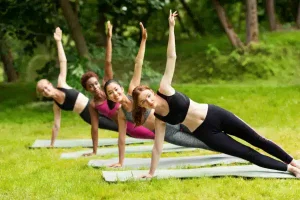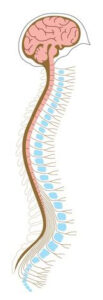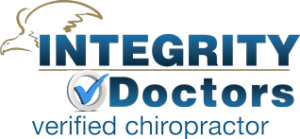The musculoskeletal (MSK) system is the “backbone” of your body, literally. It’s comprised of not only the spine but all your muscles, bones and joints. It’s what gives your body form. It’s what makes it possible for you to move and do the things you enjoy. Keeping this vital system strong is essential for a full and active life.
 When your MSK system is functioning well, you feel stronger and healthier; however, when there’s a problem you might experience pain and even disability. More than one in two adults report experiencing a musculoskeletal condition such as back pain, neck pain, joint pain, arthritis and osteoporosis. They are the most commonly reported medical conditions among those under age 65 and the second most common condition for people age 65 and older.1
When your MSK system is functioning well, you feel stronger and healthier; however, when there’s a problem you might experience pain and even disability. More than one in two adults report experiencing a musculoskeletal condition such as back pain, neck pain, joint pain, arthritis and osteoporosis. They are the most commonly reported medical conditions among those under age 65 and the second most common condition for people age 65 and older.1
MSK conditions become more common as we age, sometimes limiting our ability to move and accomplish everyday activities. This can affect overall health negatively by contributing to lack of physical activity, which can in turn lead to obesity and chronic conditions such as Type 2 diabetes and hypertension. MSK pain and disability can also lead to problems such as social isolation, depression and even loss of independence.
Nurturing musculoskeletal health over a lifetime begins with good nutrition, adequate hydration and healthy habits such as regular rest and physical activity. Prevention is also key; we can reduce the risk of pain and injury by improving our posture and movement techniques as well the ergonomics of our work and home environments.
The American Chiropractic Association offers the following small steps to take toward better musculoskeletal health:
Steps to Strength
- Move more. Bones, muscles and joints need movement to stay healthy. The U.S. surgeon general recommends adults get at least 150 minutes weekly of moderate physical activity (walking, yard work, recreational swimming, etc.) or at least 75 minutes of intense weekly activity (jogging, hiking uphill, basketball, etc.).2
- Eat a balanced diet. Proper nutrition is just as important to musculoskeletal health as it is to overall health. Eat a balanced diet that includes whole fresh foods and try to avoid processed foods. Be sure to get enough calcium and vitamin D for your bones and lean protein to build and maintain strong muscles.3
- Go outside! The sun helps our bodies produce Vitamin D, which in turn helps to absorb calcium and strengthen bones.3
- Do weight-bearing exercises. Walking, jogging and resistance exercises such as weightlifting can improve bone density. Planks and squats can also strengthen core muscles. Non-weight-bearing exercises such as swimming and biking can benefit the musculoskeletal system as well, especially for people unable to walk or jog while recovering from back, hip or knee pain.4
- Stay hydrated. Drinking water makes muscles stronger by carrying oxygen to the cells of the body. It also helps lubricate and cushion joints.5
- Quit smoking. It contributes not only to cardiovascular disease but also osteoporosis and bone fracture as we age.6
- Get adequate rest. A good night’s sleep enables your body to repair muscles and joints that are strained or injured during the day.
- Don’t drink too much alcohol. Drinking alcohol excessively can lead to osteoporosis and bone fracture.6
Steps to Stability
- Lead an active lifestyle. This contributes to a higher level of physical fitness and better spinal control as we age.7
- Practice good posture. It helps keep bones and joints in correct alignment so our muscles work more efficiently, saving energy and reducing fatigue while decreasing the abnormal wearing of joint surfaces that can lead to degenerative arthritis and joint pain.
- Maintain a healthy weight. Being overweight can put stress on joints, especially as we age, leading to an increased risk of injury. However, being underweight can increase the risk of bone loss and fracture.3
- Make your environment MSK-friendly to promote good posture and prevent strain. Computer workstation tip: Keep your monitor raised to eye level so you don’t bend your neck down while looking at the screen; keep your elbows at a 95-degree angle as you type; and take regular breaks to stand up and move around.
- Improve movement techniques to avoid strain and injury. Lifting tip: When picking up heavy items from the floor, do not bend over at the waist; instead, kneel down on one knee, as close as possible to the item you are lifting, with the other foot flat on the floor and pick up the item. Alternatively, bend both knees, keeping the item close to your body, and lift with the legs.
- Limit screen time. Neck pain and poor posture can result from spending too much time looking down at your tablet or cell phone. Spend less time on mobile devices and do stretch and extension exercises regularly. Bring your shoulder blades together and stand up tall.
- Be proactive and prevent falls. Remove throw rugs, low furniture, cords and other trip hazards on the floor; review medications with your doctor that could affect balance; have your vision checked; and start an exercise routine to improve strength, balance, coordination and flexibility.
Enjoy Your MSK Success!
By strengthening your musculoskeletal system, you can stay healthier and engaged in the activities that matter most to you, whether that’s participating in your favorite sport or just keeping up with your grandchildren at the playground. When strain or injury does occur, healthcare authorities such as the American College of Physicians and the CDC recommend a conservative approach to pain management that involves first trying non-drug treatments before moving on to medications and surgery.8
This approach has largely been a response to the opioid crisis in the United States, which has been fueled in part by MSK disorders. Low back pain, for example, is one of the most common conditions for which opioids are prescribed.9
Whatever your MSK health goals are, your doctor of chiropractic can help. Chiropractors practice a hands-on, non-drug approach to health care. In addition to their expertise in spinal manipulation, they have broad diagnostic skills and are trained to recommend therapeutic and rehabilitative exercises, as well as to provide nutritional, dietary and lifestyle advice.
References
- The Hidden Impact of Musculoskeletal Disorders on Americans,United State Bone and Joint Initiative, 2018.
- Physical Activity Guidelines for Americans, 2nd Edition, U.S. Dept. of Health and Human Services, https://health.gov/paguidelines/second-edition/
- The Surgeon General’s Report on Bone Health and Osteoporosis: What It Means to You, National Institutes of Health, https://www.bones.nih.gov/health-info/bone/SGR/surgeongeneralsreport#l
- “Exercise for Your Bone Health,” National institutes of Health, https://www.bones.nih.gov/health-info/bone/bone-health/exercise/exercise-your-bone-health
- “Water and Nutrition,” Centers for Disease Control and Prevention,https://www.cdc.gov/healthywater/drinking/nutrition/index.html)
- “Smoking and Bone Health,” National Institutes of Health, https://www.bones.nih.gov/health-info/bone/osteoporosis/conditionsbehaviors/bone-smoking
- Aasa U et al. Physical activity might be of greater Importance for good spinal control than if you have had pain or not. Spine 2015;40:1926–1933.
- Qaseem A et al. Noninvasive treatments for acute, subacute, and chronic low back pain: A clinical practice guideline from the American College of Physicians. Ann Intern Med. 2017;166(7):514-530. doi: 10.7326/M16-2367.
- Mojtabai R. National trends in long-term use of prescription opioids. Pharmacoepidemiology and Drug Safety, 2017; doi 10.1002/pds.4278.
Schedule an Appointment - We are here to help you!
Overland Park, KS Clinic
6701 W. 121st Street | Suite 200
Overland Park, KS 66209
913-643-1771
913-643-1775
Olathe, KS Clinic
10454 S. Ridgeview Rd.
Olathe, KS 66061
913-689-2333
913-689-2334
Prairie Village, KS Clinic
4121 W. 83rd St. | Suite 147
Prairie Village, KS 66208
913-490-4444
913-490-4445
Raytown, MO Clinic
10803 E State Rte 350 | Suite B
Raytown MO 64138
816-356-9313
816-425-2117
Lee's Summit, MO Clinic
338 Southwest Main St.
Lee's Summit, MO 64063
816-600-5483
816-524-5328
Belton/Raymore, MO Clinic
17027 Bel-Ray Blvd.
Belton, MO 64012
816-425-7015
816-425-2117
Blue Springs, MO Clinic
622 SW US 40 Hwy
Blue Springs, MO 64014
816-815-7007
816-815-7008
Liberty, MO Clinic
1520 N. Church Rd | Suite C
Liberty, MO 64068
816-831-3600
816-831-3601






